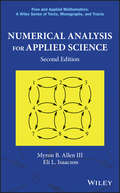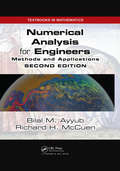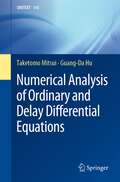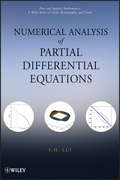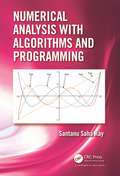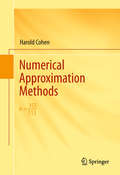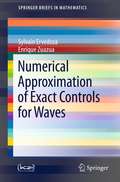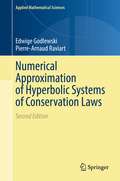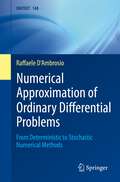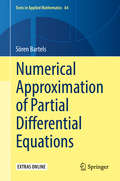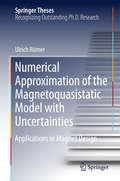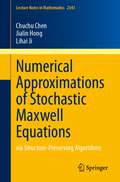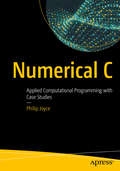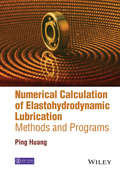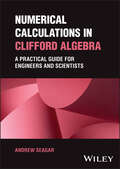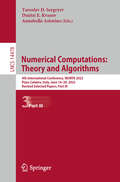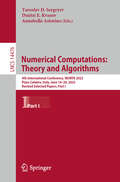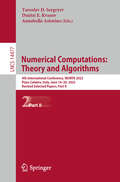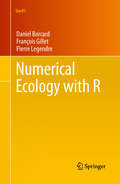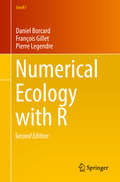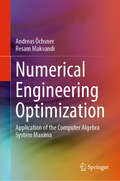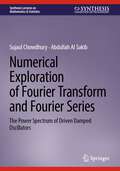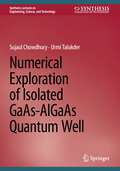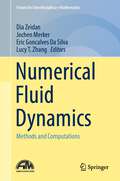- Table View
- List View
Numerical Analysis for Applied Science (Pure and Applied Mathematics: A Wiley Series of Texts, Monographs and Tracts #35)
by Myron B. Allen III Eli L. IsaacsonPragmatic and Adaptable Textbook Meets the Needs of Students and Instructors from Diverse Fields Numerical analysis is a core subject in data science and an essential tool for applied mathematicians, engineers, and physical and biological scientists. This updated and expanded edition of Numerical Analysis for Applied Science follows the tradition of its precursor by providing a modern, flexible approach to the theory and practical applications of the field. As before, the authors emphasize the motivation, construction, and practical considerations before presenting rigorous theoretical analysis. This approach allows instructors to adapt the textbook to a spectrum of uses, ranging from one-semester, methods-oriented courses to multi-semester theoretical courses. The book includes an expanded first chapter reviewing useful tools from analysis and linear algebra. Subsequent chapters include clearly structured expositions covering the motivation, practical considerations, and theory for each class of methods. The book includes over 250 problems exploring practical and theoretical questions and 32 pseudocodes to help students implement the methods. Other notable features include: A preface providing advice for instructors on using the text for a single semester course or multiple-semester sequence of courses Discussion of topics covered infrequently by other texts at this level, such as multidimensional interpolation, quasi-Newton methods in several variables, multigrid methods, preconditioned conjugate-gradient methods, finite-difference methods for partial differential equations, and an introduction to finite-element theory New topics and expanded treatment of existing topics to address developments in the field since publication of the first edition More than twice as many computational and theoretical exercises as the first edition. Numerical Analysis for Applied Science, Second Edition provides an excellent foundation for graduate and advanced undergraduate courses in numerical methods and numerical analysis. It is also an accessible introduction to the subject for students pursuing independent study in applied mathematics, engineering, and the physical and life sciences and a valuable reference for professionals in these areas.
Numerical Analysis for Engineers and Scientists
by G. MillerStriking a balance between theory and practice, this graduate-level text is perfect for students in the applied sciences. The author provides a clear introduction to the classical methods, how they work and why they sometimes fail. Crucially, he also demonstrates how these simple and classical techniques can be combined to address difficult problems. Many worked examples and sample programs are provided to help the reader make practical use of the subject material. Further mathematical background, if required, is summarized in an appendix. Topics covered include classical methods for linear systems, eigenvalues, interpolation and integration, ODEs and data fitting, and also more modern ideas like adaptivity and stochastic differential equations.
Numerical Analysis for Engineers: Methods and Applications, Second Edition (Textbooks In Mathematics Ser.)
by Richard H. McCuen Bilal AyyubNumerical Analysis for Engineers: Methods and Applications demonstrates the power of numerical methods in the context of solving complex engineering and scientific problems. The book helps to prepare future engineers and assists practicing engineers in understanding the fundamentals of numerical methods, especially their applications, limitations,
Numerical Analysis of Ordinary and Delay Differential Equations (UNITEXT #145)
by Taketomo Mitsui Guang-Da HuThis book serves as a concise textbook for students in an advanced undergraduate or first-year graduate course in various disciplines such as applied mathematics, control, and engineering, who want to understand the modern standard of numerical methods of ordinary and delay differential equations. Experts in the same fields can also learn about the recent developments in numerical analysis of such differential systems. Ordinary differential equations (ODEs) provide a strong mathematical tool to express a wide variety of phenomena in science and engineering. Along with its own significance, one of the powerful directions toward which ODEs extend is to incorporate an unknown function with delayed argument. This is called delay differential equations (DDEs), which often appear in mathematical modelling of biology, demography, epidemiology, and control theory. In some cases, the solution of a differential equation can be obtained by algebraic combinations of known mathematical functions. In many practical cases, however, such a solution is quite difficult or unavailable, and numerical approximations are called for. Modern development of computers accelerates the situation and, moreover, launches more possibilities of numerical means. Henceforth, the knowledge and expertise of the numerical solution of differential equations becomes a requirement in broad areas of science and engineering.One might think that a well-organized software package such as MATLAB serves much the same solution. In a sense, this is true; but it must be kept in mind that blind employment of software packages misleads the user. The gist of numerical solution of differential equations still must be learned. The present book is intended to provide the essence of numerical solutions of ordinary differential equations as well as of delay differential equations. Particularly, the authors noted that there are still few concise textbooks of delay differential equations, and then they set about filling the gap through descriptions as transparent as possible. Major algorithms of numerical solution are clearly described in this book. The stability of solutions of ODEs and DDEs is crucial as well. The book introduces the asymptotic stability of analytical and numerical solutions and provides a practical way to analyze their stability by employing a theory of complex functions.
Numerical Analysis of Partial Differential Equations
by Lui S. HA balanced guide to the essential techniques for solving elliptic partial differential equations Numerical Analysis of Partial Differential Equations provides a comprehensive, self-contained treatment of the quantitative methods used to solve elliptic partial differential equations (PDEs), with a focus on the efficiency as well as the error of the presented methods. The author utilizes coverage of theoretical PDEs, along with the nu merical solution of linear systems and various examples and exercises, to supply readers with an introduction to the essential concepts in the numerical analysis of PDEs.The book presents the three main discretization methods of elliptic PDEs: finite difference, finite elements, and spectral methods. Each topic has its own devoted chapters and is discussed alongside additional key topics, including:The mathematical theory of elliptic PDEsNumerical linear algebraTime-dependent PDEsMultigrid and domain decompositionPDEs posed on infinite domainsThe book concludes with a discussion of the methods for nonlinear problems, such as Newton's method, and addresses the importance of hands-on work to facilitate learning. Each chapter concludes with a set of exercises, including theoretical and programming problems, that allows readers to test their understanding of the presented theories and techniques. In addition, the book discusses important nonlinear problems in many fields of science and engineering, providing information as to how they can serve as computing projects across various disciplines.Requiring only a preliminary understanding of analysis, Numerical Analysis of Partial Differential Equations is suitable for courses on numerical PDEs at the upper-undergraduate and graduate levels. The book is also appropriate for students majoring in the mathematical sciences and engineering.
Numerical Analysis with Algorithms and Programming
by Santanu Saha RayNumerical Analysis with Algorithms and Programming is the first comprehensive textbook to provide detailed coverage of numerical methods, their algorithms, and corresponding computer programs. It presents many techniques for the efficient numerical solution of problems in science and engineering. Along with numerous worked-out examples, end-of-chapter exercises, and Mathematica® programs, the book includes the standard algorithms for numerical computation: Root finding for nonlinear equations Interpolation and approximation of functions by simpler computational building blocks, such as polynomials and splines The solution of systems of linear equations and triangularization Approximation of functions and least square approximation Numerical differentiation and divided differences Numerical quadrature and integration Numerical solutions of ordinary differential equations (ODEs) and boundary value problems Numerical solution of partial differential equations (PDEs) The text develops students’ understanding of the construction of numerical algorithms and the applicability of the methods. By thoroughly studying the algorithms, students will discover how various methods provide accuracy, efficiency, scalability, and stability for large-scale systems.
Numerical Approximation Methods: π ≈ 355/113
by Harold CohenThis book presents numerical and other approximation techniques for solving various types of mathematical problems that cannot be solved analytically. In addition to well known methods, it contains some non-standard approximation techniques that are now formally collected as well as original methods developed by the author that do not appear in the literature. This book contains an extensive treatment of approximate solutions to various types of integral equations, a topic that is not often discussed in detail. There are detailed analyses of ordinary and partial differential equations and descriptions of methods for estimating the values of integrals that are presented in a level of detail that will suggest techniques that will be useful for developing methods for approximating solutions to problems outside of this text. The book is intended for researchers who must approximate solutions to problems that cannot be solved analytically. It is also appropriate for students taking courses in numerical approximation techniques.
Numerical Approximation of Exact Controls for Waves
by Enrique Zuazua Sylvain ErvedozaThis book is devoted to fully developing and comparing the two main approaches to the numerical approximation of controls for wave propagation phenomena: the continuous and the discrete. This is accomplished in the abstract functional setting of conservative semigroups.The main results of the work unify, to a large extent, these two approaches, which yield similaralgorithms and convergence rates. The discrete approach, however, gives not only efficient numerical approximations of the continuous controls, but also ensures some partial controllability properties of the finite-dimensional approximated dynamics. Moreover, it has the advantage of leading to iterative approximation processes that converge without a limiting threshold in the number of iterations. Such a threshold, which is hard to compute and estimate in practice, is a drawback of the methods emanating from the continuous approach. To complement this theory, the book provides convergence results for the discrete wave equation when discretized using finite differences and proves the convergence of the discrete wave equation with non-homogeneous Dirichlet conditions. The first book to explore these topics in depth, "On the Numerical Approximations of Controls for Waves" has rich applications to data assimilation problems and will be of interest to researchers who deal with wave approximations.
Numerical Approximation of Hyperbolic Systems of Conservation Laws (Applied Mathematical Sciences #118)
by Edwige Godlewski Pierre-Arnaud RaviartThis monograph is devoted to the theory and approximation by finite volume methods of nonlinear hyperbolic systems of conservation laws in one or two space variables. It follows directly a previous publication on hyperbolic systems of conservation laws by the same authors. Since the earlier work concentrated on the mathematical theory of multidimensional scalar conservation laws, this book will focus on systems and the theoretical aspects which are needed in the applications, such as the solution of the Riemann problem and further insights into more sophisticated problems, with special attention to the system of gas dynamics. This new edition includes more examples such as MHD and shallow water, with an insight on multiphase flows. Additionally, the text includes source terms and well-balanced/asymptotic preserving schemes, introducing relaxation schemes and addressing problems related to resonance and discontinuous fluxes while adding details on the low Mach number situation.
Numerical Approximation of Ordinary Differential Problems: From Deterministic to Stochastic Numerical Methods (UNITEXT #148)
by Raffaele D'AmbrosioThis book is focused on the numerical discretization of ordinary differential equations (ODEs), under several perspectives. The attention is first conveyed to providing accurate numerical solutions of deterministic problems. Then, the presentation moves to a more modern vision of numerical approximation, oriented to reproducing qualitative properties of the continuous problem along the discretized dynamics over long times. The book finally performs some steps in the direction of stochastic differential equations (SDEs), with the intention of offering useful tools to generalize the techniques introduced for the numerical approximation of ODEs to the stochastic case, as well as of presenting numerical issues natively introduced for SDEs.The book is the result of an intense teaching experience as well as of the research carried out in the last decade by the author. It is both intended for students and instructors: for the students, this book is comprehensive and rather self-contained; for the instructors, there is material for one or more monographic courses on ODEs and related topics. In this respect, the book can be followed in its designed path and includes motivational aspects, historical background, examples and a software programs, implemented in Matlab, that can be useful for the laboratory part of a course on numerical ODEs/SDEs.The book also contains the portraits of several pioneers in the numerical discretization of differential problems, useful to provide a framework to understand their contributes in the presented fields. Last, but not least, rigor joins readability in the book.
Numerical Approximation of Partial Differential Equations
by Sören BartelsFinite element methods for approximating partial differential equations have reached a high degree of maturity, and are an indispensible tool in science and technology. This textbook aims at providing a thorough introduction to the construction, analysis, and implementation of finite element methods for model problems arising in continuum mechanics. The first part of the book discusses elementary properties of linear partial differential equations along with their basic numerical approximation, the functional-analytical framework for rigorously establishing existence of solutions, and the construction and analysis of basic finite element methods. The second part is devoted to the optimal adaptive approximation of singularities and the fast iterative solution of linear systems of equations arising from finite element discretizations. In the third part, the mathematical framework for analyzing and discretizing saddle-point problems is formulated, corresponding finte element methods are analyzed, and particular applications including incompressible elasticity, thin elastic objects, electromagnetism, and fluid mechanics are addressed. The book includes theoretical problems and practical projects for all chapters, and an introduction to the implementation of finite element methods.
Numerical Approximation of the Magnetoquasistatic Model with Uncertainties
by Ulrich RömerThis book presents a comprehensive mathematical approach for solving stochastic magnetic field problems. It discusses variability in material properties and geometry, with an emphasis on the preservation of structural physical and mathematical properties. It especially addresses uncertainties in the computer simulation of magnetic fields originating from the manufacturing process. Uncertainties are quantified by approximating a stochastic reformulation of the governing partial differential equation, demonstrating how statistics of physical quantities of interest, such as Fourier harmonics in accelerator magnets, can be used to achieve robust designs. The book covers a number of key methods and results such as: a stochastic model of the geometry and material properties of magnetic devices based on measurement data; a detailed description of numerical algorithms based on sensitivities or on a higher-order collocation; an analysis of convergence and efficiency; and the application of the developed model and algorithms to uncertainty quantification in the complex magnet systems used in particle accelerators.
Numerical Approximations of Stochastic Maxwell Equations: via Structure-Preserving Algorithms (Lecture Notes in Mathematics #2341)
by Jialin Hong Chuchu Chen Lihai JiThe stochastic Maxwell equations play an essential role in many fields, including fluctuational electrodynamics, statistical radiophysics, integrated circuits, and stochastic inverse problems. This book provides some recent advances in the investigation of numerical approximations of the stochastic Maxwell equations via structure-preserving algorithms. It presents an accessible overview of the construction and analysis of structure-preserving algorithms with an emphasis on the preservation of geometric structures, physical properties, and asymptotic behaviors of the stochastic Maxwell equations. A friendly introduction to the simulation of the stochastic Maxwell equations with some structure-preserving algorithms is provided using MATLAB for the reader’s convenience. The objects considered in this book are related to several fascinating mathematical fields: numerical analysis, stochastic analysis, (multi-)symplectic geometry, large deviations principle, ergodic theory, partial differential equation, probability theory, etc. This book will appeal to researchers who are interested in these topics.
Numerical C: Applied Computational Programming with Case Studies
by Philip JoyceLearn applied numerical computing using the C programming language, starting with a quick primer on the C programming language and its SDK. This book then dives into progressively more complex applied math formula for computational methods using C with examples throughout and a larger, more complete application towards the end. Numerical C starts with the quadratic formula for finding solutions to algebraic equations that model things such as price vs. demand or rise vs. run or slip and more. Later in the book, you'll work on the augmented matrix method for simultaneous equations. You’ll also cover Monte Carlo method model objects that could arise naturally as part of the modeling of a real-life system, such as a complex road network, the transport of neutrons, or the evolution of the stock market. Furthermore, the Monte Carlo method of integration examines the area under a curve including rendering or ray tracing and the shading in a region. Furthermore, you'll work with the product moment correlation coefficient: correlation is a technique for investigating the relationship between two quantitative, continuous variables, for example, age and blood pressure. By the end of the book, you'll have a feeling for what computer software could do to help you in your work and apply some of the methods learned directly to your work. What You Will LearnGain software and C programming basicsWrite software to solve applied, computational mathematics problems Create programs to solve equations and calculus problems Use the trapezium method, Monte Carlo method, line of best fit, product moment correlation coefficient, Simpson’s rule, and matrix solutions Write code to solve differential equations Apply one or more of the methods to an application case studyWho This Book Is ForThose with an existing knowledge of rudimentary mathematics (school level) and some basic programming experience. This is also important to people who may work in mathematics or other areas (for example, life sciences, engineering, or economics) and need to learn C programming.
Numerical Calculation of Elastohydrodynamic Lubrication: Methods and Programs
by Ping HuangThe book not only offers scientists and engineers a clear inter-disciplinary introduction and orientation to all major EHL problems and their solutions but, most importantly, it also provides numerical programs on specific application in engineering.• A one-stop reference providing equations and their solutions to all major elastohydrodynamic lubrication (EHL) problems, plus numerical programs on specific applications in engineering• offers engineers and scientists a clear inter-disciplinary introduction and a concise program for practical engineering applications to most important EHL problems and their solutions• brings together a number of case studies in one text, each being solved using solution methods which share common features and methods
Numerical Calculations in Clifford Algebra: A Practical Guide for Engineers and Scientists
by Andrew SeagarNUMERICAL CALCULATIONS IN CLIFFORD ALGEBRA An intuitive combination of the theory of Clifford algebra with numerous worked and computed examples and calculations Numerical Calculations in Clifford Algebra: A Practical Guide for Engineers and Scientists is an accessible and practical introduction to Clifford algebra, with comprehensive coverage of the theory and calculations. The book offers many worked and computed examples at a variety of levels of complexity and over a range of different applications making extensive use of diagrams to maintain clarity. The author introduces and documents the Clifford Numerical Suite, developed to overcome the limitations of existing computational packages and to enable the rapid creation and deployment of sophisticated and efficient code. Applications of the suite include Fourier transforms for arrays of any types of Clifford numbers and the solution of linear systems in which the coefficients are Clifford numbers of particular types, including scalars, bicomplex numbers, quaternions, Pauli matrices, and extended electromagnetic fields. Readers will find: A thorough introduction to Clifford algebra, with a combination of theory and practical implementation in a range of engineering problems Comprehensive explorations of a variety of worked and computed examples at various levels of complexity Practical discussions of the conceptual and computational tools for solving common engineering problems Detailed documentation on the deployment and application of the Clifford Numerical Suite Perfect for engineers, researchers, and academics with an interest in Clifford algebra, Numerical Calculations in Clifford Algebra: A Practical Guide for Engineers and Scientists will particularly benefit professionals in the areas of antenna design, digital image processing, theoretical physics, and geometry.
Numerical Computations: 4th International Conference, NUMTA 2023, Pizzo Calabro, Italy, June 14–20, 2023 Revised Selected Papers, Part III (Lecture Notes in Computer Science #14478)
by Yaroslav D. Sergeyev Dmitri E. Kvasov Annabella AstorinoThe three-volume set LNCS 14476-14478 constitutes the post conference proceedings of the 4th International Conference on Numerical Computations: Theory and Algorithms, NUMTA 2023, held in Pizzo Calabro, Italy, during June 14-20, 2023. The 45 full papers presented in this book together with 60 short papers were carefully reviewed and selected from 170 submissions. The papers focus on topics such as: continuous and discrete single- and multi-objective problems, local, global and large-scale optimization, classification in machine learning, optimal control, and applications; computational and applied mathematics (such as approximation theory, computational geometry, computational fluid dynamics, dynamical systems and differential equations, numerical algebra, etc.) and applications in engineering and science; numerical models, methods and software using traditional and emerging high-performance computational tools and paradigms (including the infinity and quantum computing) and their application in artificial intelligence and data science, bioinformatics, economics and management, engineering and technology, mathematical education, number theory and foundations of mathematics, etc.
Numerical Computations: 4th International Conference, NUMTA 2023, Pizzo Calabro, Italy, June 14–20, 2023, Revised Selected Papers, Part I (Lecture Notes in Computer Science #14476)
by Yaroslav D. Sergeyev Dmitri E. Kvasov Annabella AstorinoThe three-volume set LNCS 14476-14478 constitutes the post conference proceedings of the 4th International Conference on Numerical Computations: Theory and Algorithms, NUMTA 2023, held in Pizzo Calabro, Italy, during June 14–20, 2023. The 45 full papers presented in this book together with 60 short papers were carefully reviewed and selected from 170 submissions. The papers focus on topics such as: continuous and discrete single- and multi-objective problems, local, global and large-scale optimization, classification in machine learning, optimal control, and applications; computational and applied mathematics (such as approximation theory, computational geometry, computational fluid dynamics, dynamical systems and differential equations, numerical algebra, etc.) and applications in engineering and science; numerical models, methods and software using traditional and emerging high-performance computational tools and paradigms (including the infinity and quantum computing) and their application in artificial intelligence and data science, bioinformatics, economics and management, engineering and technology, mathematical education, number theory and foundations of mathematics, etc.
Numerical Computations: 4th International Conference, NUMTA 2023, Pizzo Calabro, Italy, June 14–20, 2023, Revised Selected Papers, Part II (Lecture Notes in Computer Science #14477)
by Yaroslav D. Sergeyev Dmitri E. Kvasov Annabella AstorinoThe three-volume set LNCS 14476-14478 constitutes the post conference proceedings of the 4th International Conference on Numerical Computations: Theory and Algorithms, NUMTA 2023, held in Pizzo Calabro, Italy, during June 14-20, 2023. The 45 full papers presented in this book together with 60 short papers were carefully reviewed and selected from 170 submissions. The papers focus on topics such as: continuous and discrete single- and multi-objective problems, local, global and large-scale optimization, classification in machine learning, optimal control, and applications; computational and applied mathematics (such as approximation theory, computational geometry, computational fluid dynamics, dynamical systems and differential equations, numerical algebra, etc.) and applications in engineering and science; numerical models, methods and software using traditional and emerging high-performance computational tools and paradigms (including the infinity and quantum computing) and their application in artificial intelligence and data science, bioinformatics, economics and management, engineering and technology, mathematical education, number theory and foundations of mathematics, etc.
Numerical Ecology with R
by Francois Gillet Daniel Borcard Pierre LegendreNumerical Ecology with R provides a long-awaited bridge between a textbook in Numerical Ecology and the implementation of this discipline in the R language. After short theoretical overviews, the authors accompany the users through the exploration of the methods by means of applied and extensively commented examples. Users are invited to use this book as a teaching companion at the computer. The travel starts with exploratory approaches, proceeds with the construction of association matrices, then addresses three families of methods: clustering, unconstrained and canonical ordination, and spatial analysis. All the necessary data files, the scripts used in the chapters, as well as the extra R functions and packages written by the authors, can be downloaded from a web page accessible through the Springer web site(http://adn.biol.umontreal.ca/~numericalecology/numecolR/). This book is aimed at professional researchers, practitioners, graduate students and teachers in ecology, environmental science and engineering, and in related fields such as oceanography, molecular ecology, agriculture and soil science, who already have a background in general and multivariate statistics and wish to apply this knowledge to their data using the R language, as well as people willing to accompany their disciplinary learning with practical applications. People from other fields (e.g. geology, geography, paleoecology, phylogenetics, anthropology, the social and education sciences, etc.) may also benefit from the materials presented in this book. The three authors teach numerical ecology, both theoretical and practical, to a wide array of audiences, in regular courses in their Universities and in short courses given around the world. Daniel Borcard is lecturer of Biostatistics and Ecology and researcher in Numerical Ecology at Université de Montréal, Québec, Canada. François Gillet is professor of Community Ecology and Ecological Modelling at Université de Franche-Comté, Besançon, France. Pierre Legendre is professor of Quantitative Biology and Ecology at Université de Montréal, Fellow of the Royal Society of Canada, and ISI Highly Cited Researcher in Ecology/Environment.
Numerical Ecology with R (Use R!)
by Daniel Borcard Pierre Legendre François GilletThis new edition of Numerical Ecology with R guides readers through an applied exploration of the major methods of multivariate data analysis, as seen through the eyes of three ecologists. It provides a bridge between a textbook of numerical ecology and the implementation of this discipline in the R language. The book begins by examining some exploratory approaches. It proceeds logically with the construction of the key building blocks of most methods, i.e. association measures and matrices, and then submits example data to three families of approaches: clustering, ordination and canonical ordination. The last two chapters make use of these methods to explore important and contemporary issues in ecology: the analysis of spatial structures and of community diversity. The aims of methods thus range from descriptive to explanatory and predictive and encompass a wide variety of approaches that should provide readers with an extensive toolbox that can address a wide palette of questions arising in contemporary multivariate ecological analysis. The second edition of this book features a complete revision to the R code and offers improved procedures and more diverse applications of the major methods. It also highlights important changes in the methods and expands upon topics such as multiple correspondence analysis, principal response curves and co-correspondence analysis. New features include the study of relationships between species traits and the environment, and community diversity analysis. This book is aimed at professional researchers, practitioners, graduate students and teachers in ecology, environmental science and engineering, and in related fields such as oceanography, molecular ecology, agriculture and soil science, who already have a background in general and multivariate statistics and wish to apply this knowledge to their data using the R language, as well as people willing to accompany their disciplinary learning with practical applications. People from other fields (e.g. geology, geography, paleoecology, phylogenetics, anthropology, the social and education sciences, etc.) may also benefit from the materials presented in this book. Users are invited to use this book as a teaching companion at the computer. All the necessary data files, the scripts used in the chapters, as well as extra R functions and packages written by the authors of the book, are available online (URL: http://adn.biol.umontreal.ca/~numericalecology/numecolR/).
Numerical Engineering Optimization: Application of the Computer Algebra System Maxima
by Andreas Öchsner Resam MakvandiThis study aid on numerical optimization techniques is intended for university undergraduate and postgraduate mechanical engineering students. Optimization procedures are becoming more and more important for lightweight design, where weight reduction can, for example in the case of automotive or aerospace industry, lead to lower fuel consumption and a corresponding reduction in operational costs as well as beneficial effects on the environment. Based on the free computer algebra system Maxima, the authors present procedures for numerically solving problems in engineering mathematics as well as applications taken from traditional courses on the strength of materials. The mechanical theories focus on the typical one-dimensional structural elements, i.e., springs, bars, and Euler–Bernoulli beams, in order to reduce the complexity of the numerical framework and limit the resulting design to a low number of variables. The use of a computer algebra system and the incorporated functions, e.g., for derivatives or equation solving, allows a greater focus on the methodology of the optimization methods and not on standard procedures. The book also provides numerous examples, including some that can be solved using a graphical approach to help readers gain a better understanding of the computer implementation.
Numerical Exploration of Fourier Transform and Fourier Series: The Power Spectrum of Driven Damped Oscillators (Synthesis Lectures on Mathematics & Statistics)
by Sujaul Chowdhury Abdullah Al SakibThis book presents practical demonstrations of numerically calculating or obtaining Fourier Transform. In particular, the authors demonstrate how to obtain frequencies that are present in numerical data and utilizes Mathematica to illustrate the calculations. This book also contains numerical solution of differential equation of driven damped oscillator using 4th order Runge-Kutta method. Numerical solutions are compared with analytical solutions, and the behaviors of mechanical system are also depicted by plotting velocity versus displacement rather than displaying displacement as a function of time. This book is useful to physical science and engineering professionals who often need to obtain frequencies present in numerical data using the discrete Fourier transform.This book: Aids readers to numerically calculate or obtain frequencies that are present in numerical dataExplores the use of the discrete Fourier transform and demonstrates practical numerical calculationUtilizes 4th order Runge-Kutta method and Mathematica for the numerical solution of differential equation
Numerical Exploration of Isolated GaAs-AlGaAs Quantum Well (Synthesis Lectures on Engineering, Science, and Technology)
by Sujaul Chowdhury Urmi TalukderThis book begins with the eigenvalue equation of energy and presents calculation of the energy spectrum of GaAs-AlGaAs Quantum Well using finite difference method and knowledge of potential energy profile, without using expressions for eigenfunctions, continuity of eigenfunctions, or their spatial derivatives at the two abrupt potential steps. The authors find that the results are almost the same as those obtained by solving numerically using regula falsi method, and transcendental equations that are obeyed by the energy levels, where the transcendental equations are obtained by requiring continuity of eigenfunctions and of their spatial derivatives at the two potential steps. Thus, this book confirms that it is possible to numerically calculate the energy spectrum of Quantum Well by the finite difference method when it is not correct or when it is not possible to use continuity of eigenfunctions and their spatial derivatives at the two abrupt potential steps. The authors also showthat it is possible to use the finite difference method in cases where the potential steps are non-abrupt. The book demonstrates this by calculating the energy spectrum of isolated parabolic Quantum Well of finite depth using finite difference method.
Numerical Fluid Dynamics: Methods and Computations (Forum for Interdisciplinary Mathematics)
by Dia Zeidan Lucy T. Zhang Eric Goncalves Da Silva Jochen MerkerThis book contains select invited chapters on the latest research in numerical fluid dynamics and applications. The book aims at discussing the state-of-the-art developments and improvements in numerical fluid dynamics. All the chapters are presented for approximating and simulating how these methods and computations interact with different topics such as shock waves, non-equilibrium single and two-phase flows, elastic human-airway, and global climate. In addition to the fundamental research involving novel types of mathematical sciences, the book presents theoretical and numerical developments in fluid dynamics. The contributions by well-established global experts in fluid dynamics have brought different features of numerical fluid dynamics in a single book. The book serves as a useful resource for high-impact advances involving computational fluid dynamics, including recent developments in mathematical modelling, numerical methods such as finite volume, finite difference and finite element, symbolic computations, and open numerical programs such as OpenFOAM software. The book addresses interdisciplinary topics in industrial mathematics that lie at the forefront of research into new types of mathematical sciences, including theory and applications. This book will be beneficial to industrial and academic researchers, as well as graduate students, working in the fields of natural and engineering sciences. The book will provide the reader highly successful materials and necessary research in the field of fluid dynamics.
